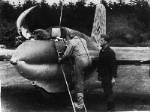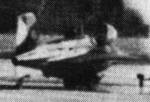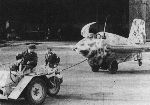1. Light grey overall
Many, or possibly all, early Me 163B's were painted in a grey color overall, and flown for some time it that color. Some facts were recorded by RAF intelligence, as found in Public Record Office file AIR 40/198. A reconnaissance flight of Bad Zwischenahn on 8 May 1944 showed five or six Me 163 present, and it was remarked "It is of interest to note that all these aircraft appear to have normal aircraft camouflage, whereas most of the aircraft seen previously at this airfield have been light-coloured." A recce flight over Jesau (the production test flying facility) on 29 June 1944 showed 10 Komets present, with the comment "It may be of interest to note that all the Me 163s were light-coloured." It is not easy to establish exactly which WNr were being flight tested at that time, but very likely they were either the last of the 70 aircraft Messerschmitt production block, or early examples of the first Klemm production block (WNr 4400xx). The first operational recording of a Klemm aircraft is 440009 that crash landed at Venlo on 26 July 1944. At least the observation strongly suggest that at least 70 Komets were delivered without camouflage. It also explains the wide variety in camouflages on early Komets, since they were applied in the field, probably without strict instructions or a painting scheme.
The second issue is what grey color was used on these aircraft. The likely options are RLM02, RLM65 and RLM76. I always thought that RLM02 was unlikely, since that color has a much warmer appearance in most photos, see this selection of RLM02 painted prototypes. Possibly, but this is very much unconfirmed, the warmer appearance is caused by the yellow component in RLM02? If the observation is correct, RLM65 and RLM76 remain.
|
|






















